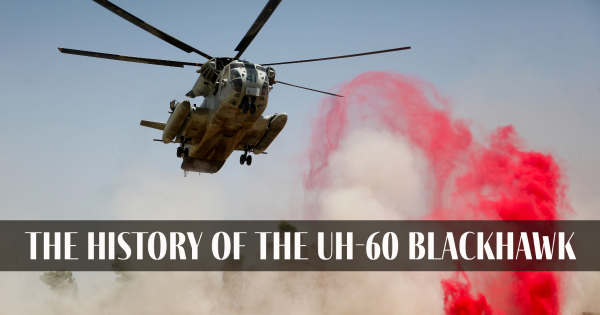Making Best Use Of Safety And Security: Crucial Upkeep Tips for Your UH 60 Helicopter
Making Best Use Of Safety And Security: Crucial Upkeep Tips for Your UH 60 Helicopter
Blog Article
Recognizing the Mechanics and Design Behind Uh 60 Helicopters
The UH-60 helicopter, commonly recognized as the Black Hawk, stands as a pinnacle of modern rotorcraft technology, symbolizing a blend of robust design and detailed technicians. As we peel off back the layers of the UH-60's layout, a globe of intricate systems and precise engineering comes to light.
History of UH-60 Helicopters
The history of UH-60 helicopters traces back to the late 1970s when the USA Military looked for a functional and sophisticated energy helicopter to change its aging fleet. In action to this requirement, the Sikorsky Aircraft Firm created the UH-60 Black Hawk helicopter. Introduced in 1979, the UH-60 promptly came to be a staple in armed forces operations as a result of its remarkable capacities.
The UH-60 was made to master a range of missions, consisting of troop transport, clinical emptying, electronic war, and special procedures. Its capability to adapt to various functions made it a valuable property to the U.S. uh 60. Military and various other military pressures all over the world
Over the years, the UH-60 system has actually undertaken numerous upgrades and variants to improve its efficiency and equal progressing objective requirements. These helicopters have seen extensive service in conflicts such as the Gulf War, Afghanistan, and Iraq, showcasing their reliability and adaptability in varied operational environments. The UH-60's rich history is a testimony to its enduring tradition as a leading utility helicopter.

Engine and Power Equipments
Using cutting-edge propulsion innovation, UH-60 helicopters are geared up with innovative engine and power systems to make certain ideal performance and dependability in a variety of functional circumstances. The UH-60, generally referred to as the Black Hawk, is powered by 2 General Electric T700-GE-701D engines, each efficient in supplying up to 1,940 shaft horsepower. These turboshaft engines offer the necessary thrust for the helicopter to accomplish its objectives properly, consisting of army transportation, clinical discharge, and battle support.

Rotor System and Aerodynamics
Just how do the blades system and aerodynamics of UH-60 helicopters add to their operational efficiency and flight capacities? The rotor system of the UH-60 helicopter plays a vital function in offering lift and propulsion. The UH-60 includes a four-bladed, completely verbalized blades system that enables for high ability to move and security throughout trip. This style enables the helicopter to perform a variety of goals, from transportation and medical emptying to combat procedures.
Aerodynamics likewise play a key role in the performance of UH-60 helicopters. The structured body and blades blade style decrease drag, allowing the helicopter to accomplish greater rates and much better fuel effectiveness. The wind resistant layout of the UH-60 additionally adds to its capacity to operate in varied environmental problems, including warm temperature levels and high elevations.
Avionics and Flight Control Equipment

In its intricate coordination with the blades system and the rules of aerodynamics of UH-60 helicopters, the avionics and flight control systems form an important network of technologies shaping the airplane's functional capacities. Avionics incorporate the digital systems made use of for communication, navigating, and monitoring different aircraft functions. In the UH-60, these systems consist of electronic displays, communication radios, GPS navigation, weather radar, and autopilot systems. These avionics systems look at these guys supply essential info to the pilots, boosting situational recognition and ensuring risk-free and reliable operation of the helicopter.
The flight control systems of the UH-60 are accountable for equating the pilot's inputs into the proper modifications to the blades system, making sure steady trip and ability to move. These systems include hydraulic actuators, servos, and computer systems that function together to control the primary and tail blades, as well as other flight control surfaces. By exactly taking care of the helicopter's trip dynamics, these systems allow pilots to execute a wide variety of goals, from transport and search-and-rescue to fight operations, with accuracy and self-confidence.
Role and Applications in Aviation
Avionics systems in UH-60 helicopters include a range of electronic systems that aid in navigation, communication, monitoring, and controlling different airplane functions. These systems consist of electronic display screens, autopilot systems, communication radios, linked here General practitioner navigating tools, and weather radar. Additionally, these systems integrate security features such as auto-pilot settings, surface awareness cautioning systems, and security augmentation systems to boost the overall safety and functional capabilities of the UH-60 helicopters in check my reference various missions, consisting of troop transportation, clinical evacuation, search and rescue, and aerial firefighting.
Verdict
In final thought, the UH-60 helicopter is a functional airplane with an abundant history and advanced engineering. Its engine and power systems, rotor system, the rules of aerodynamics, avionics, and flight control systems all work together to make it a effective and trusted device.
In its elaborate control with the blades system and the rules of aerodynamics of UH-60 helicopters, the avionics and trip control systems form an essential network of technologies shaping the airplane's operational capacities.The flight control systems of the UH-60 are liable for equating the pilot's inputs into the ideal changes to the rotor system, making certain secure flight and ability to move. Avionics systems in UH-60 helicopters incorporate an array of electronic systems that help in navigating, interaction, tracking, and managing numerous aircraft functions. Furthermore, these systems include safety attributes such as autopilot settings, terrain awareness advising systems, and security enhancement systems to boost the total safety and security and functional abilities of the UH-60 helicopters in numerous goals, including army transport, clinical evacuation, search and rescue, and aerial firefighting.
Its engine and power systems, blades system, aerodynamics, avionics, and flight control systems all function with each other to make it a effective and reliable equipment.
Report this page